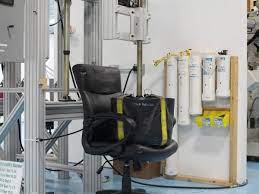Introduction
When it comes to choosing the right chairs and stools for your business or home, there are numerous factors to consider. One of the most critical aspects is their strength and durability, as these qualities directly impact the comfort and safety of users. In this article, we will delve into the ISO 7173 Strength and Durability Test, a standard widely used in the industry to evaluate chairs and stools. We’ll explore the key elements of the test, its significance, and how it can help you make informed decisions when purchasing furniture. Let’s dive in!
Understanding the ISO 7173 Test
The International Organization for Standardization (ISO) developed the ISO 7173 test to assess the strength and durability of chairs and stools. The objective of this standardized test is to simulate real-life conditions to which seating furniture may be subjected during its lifespan. By conducting this test, manufacturers, businesses, and consumers can gain valuable insights into the quality and performance of chairs and stools.
Test Procedure
1. Static Load Test (ISO 7173:1989)
The static load test involves applying a predetermined amount of weight to the seating area and legs of the chair or stool. The test is conducted with the furniture in different static positions, simulating various seating scenarios. The goal is to determine how much weight the chair can withstand without failure or deformation.
2. Leg Strength Test (ISO 7173:1989)
This test evaluates the strength and stability of the legs of the chair or stool. It involves applying a specific load to each leg individually and collectively to assess their resistance to bending and breaking.
3. Forward and Rearward Stability Test (ISO 7173:2016)
The forward and rearward stability test measures the chair’s ability to remain stable when tilted forward and backward. This evaluation is crucial to prevent potential accidents, especially in environments where users may lean or rock on the chair.
4. Seat Durability Test (ISO 7173:2016)
The seat durability test examines the ability of the chair’s seat to withstand repeated impacts over time. By applying a dynamic load to the seat, the test aims to identify any structural weaknesses or material fatigue.
5. Backrest Durability Test (ISO 7173:2016)
Similar to the seat durability test, the backrest durability test assesses the resilience of the chair’s backrest to repetitive forces. This evaluation is crucial for ensuring long-term comfort and support.
6. Armrest Durability Test (ISO 7173:2016)
For chairs with armrests, this test evaluates the armrests’ ability to endure frequent loads and impacts. It helps determine whether the armrests are well-designed and constructed to provide lasting support.
Significance of ISO 7173 Test
The ISO 7173 Strength and Durability Test hold significant importance for both manufacturers and consumers. Here’s why:
1. Quality Assurance
For manufacturers, conducting the ISO 7173 test ensures that the chairs and stools they produce meet internationally recognized quality standards. It helps them identify and rectify potential design flaws and manufacturing defects before the furniture reaches the market.
2. Safety Assurance
For consumers, relying on furniture that has undergone the ISO 7173 test provides assurance of safety and reliability. Knowing that the chairs and stools they use meet stringent durability criteria can prevent accidents and injuries.
3. Longevity and Cost-Effectiveness
Furniture that passes the ISO 7173 test is likely to have a longer lifespan, saving consumers money in the long run. Investing in durable chairs and stools reduces the need for frequent replacements and repairs.
4. Informed Decision Making
By understanding the ISO 7173 test results, consumers can make informed choices when purchasing chairs and stools. They can compare different products based on their strength and durability, selecting those that best fit their needs and usage patterns.
Choosing the Right Chairs and Stools
To make the most out of the ISO 7173 test results and choose the right chairs and stools for your business or home, consider the following factors:
1. Intended Use
Determine where the chairs or stools will be used. Different environments may require different levels of strength and durability. For example, office chairs may have different requirements compared to barstools.
2. Weight Capacity
Check the weight capacity of the furniture to ensure it can accommodate all potential users. Overloading chairs and stools can lead to premature wear and safety risks.
3. Material Quality
Inspect the materials used in the construction of the chairs and stools. High-quality materials, such as sturdy metal or reinforced plastics, contribute to better strength and durability.
4. Warranty and Certifications
Look for furniture that comes with a warranty and certifications, indicating that it has passed relevant tests like ISO 7173. This gives you added confidence in the product’s quality.
Conclusion
In conclusion, evaluating chairs and stools using the ISO 7173 Strength and Durability Test is crucial for ensuring comfort, safety, and long-term satisfaction. As a consumer, you can use the test results to make informed decisions, selecting furniture that meets your specific requirements. Manufacturers, on the other hand, can utilize the test to enhance the quality and safety of their products, gaining a competitive edge in the market. So, the next time you’re shopping for chairs and stools, keep the ISO 7173 test in mind to make a smart and confident choice.








